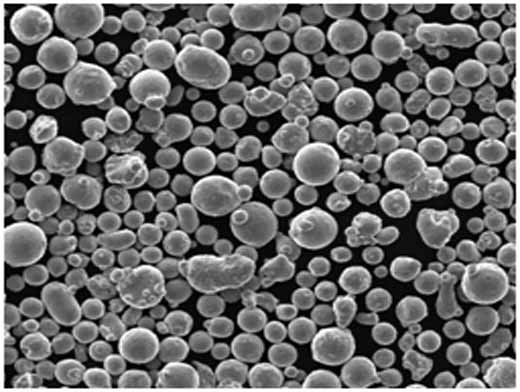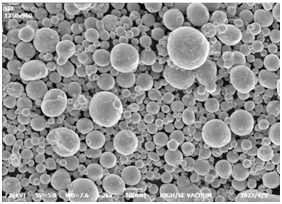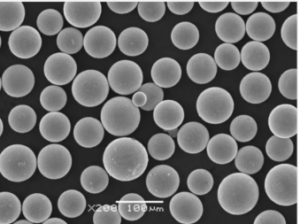Le cuivre est une pierre angulaire de la civilisation humaine, essentielle dans l'ingénierie électrique, la construction et de nombreuses applications industrielles. Lorsque l'on parle de "poudre de cuivre de haute pureténous plongeons dans un univers de matériaux qui repoussent les limites de la pureté et de la performance. La poudre de cuivre de haute pureté n'est pas un matériau comme les autres ; il s'agit d'une forme spécialisée de cuivre qui offre des qualités inégalées en matière de conductivité, de résistance à la corrosion et de gestion thermique, entre autres. Dans cet article, nous allons explorer tout ce qu'il faut savoir sur la poudre de cuivre de haute pureté, depuis sa composition et ses caractéristiques jusqu'à ses diverses applications et les différents modèles disponibles sur le marché. À la fin de ce guide, vous aurez une compréhension complète de ce matériau remarquable et des avantages qu'il peut apporter à vos projets.
Aperçu de la poudre de cuivre de haute pureté
La poudre de cuivre de haute pureté désigne le cuivre sous forme de poudre dont les niveaux de pureté sont généralement supérieurs à 99,9%. Cette poudre est utilisée dans diverses industries, notamment l'électronique, la métallurgie, l'ingénierie chimique et la fabrication de pointe, en raison de sa conductivité supérieure, de sa malléabilité et de sa résistance à la corrosion. La production de poudre de cuivre de haute pureté fait appel à plusieurs procédés sophistiqués, tels que l'électrolyse, la réduction chimique et l'atomisation, qui garantissent tous la pureté et l'homogénéité du matériau.
Dans les applications de haute technologie, où les performances ne peuvent être compromises, la poudre de cuivre de haute pureté se distingue par ses propriétés exceptionnelles. Ce guide a pour but de fournir une vue approfondie des différents types de poudres de cuivre de haute pureté disponibles, de leurs compositions, de leurs caractéristiques spécifiques et de leurs utilisations potentielles, ainsi qu'une analyse de leurs avantages et de leurs limites.

Types de poudre de cuivre de haute pureté
Différents types de poudres de cuivre de haute pureté sont conçus pour des applications spécifiques. Le tableau ci-dessous résume les principaux types de poudres de cuivre et leurs propriétés distinctes.
| Type | Niveau de pureté | Taille des particules (µm) | Méthode de production | Applications |
|---|---|---|---|---|
| Poudre de cuivre électrolytique | 99.99% | 1-10 µm | Affinage électrolytique | Électronique, frittage |
| Poudre de cuivre atomisée | 99.95% | 5-50 µm | Processus d'atomisation | Impression 3D, Gestion thermique |
| Poudre de cuivre réduite | 99.9% | 10-100 µm | Réduction chimique | Métallurgie, catalyseurs |
| Poudre de cuivre précipité | 99.95% | 0,5-10 µm | Méthode de précipitation | Pâtes conductrices, électronique |
| Nanopoudre de cuivre | 99.999% | <100 nm | Synthèse chimique | Nanotechnologies, composants de haute précision |
| Poudre de cuivre sphérique | 99.9% | 15-45 µm | atomisation du gaz | Fabrication additive, encres conductrices |
| Poudre de cuivre lamellaire | 99.9% | 1-15 µm | Fraisage | Revêtements conducteurs, lubrifiants |
| Poudre de cuivre granulaire | 99.95% | 50-150 µm | Granulation | Métallurgie des poudres, roulements |
| Poudre de cuivre de très haute pureté | 99.9999% | 1-5 µm | Affinage électrolytique spécial | Fabrication de semi-conducteurs |
| Poudre fine de cuivre | 99.97% | 5-20 µm | Broyage mécanique | Revêtement de surface, matériaux de soudage |
Composition des Poudre de cuivre de haute pureté
La composition de la poudre de cuivre de haute pureté est presque entièrement constituée de cuivre, mais les oligo-éléments présents peuvent affecter de manière significative ses propriétés et ses performances. Comprendre la composition permet de sélectionner le type de poudre adapté à des applications spécifiques.
| Composant | Concentration typique | Effet sur les propriétés |
|---|---|---|
| Cuivre (Cu) | 99.9% – 99.9999% | Excellente conductivité électrique et thermique |
| Oxygène (O) | <0,001% | Des niveaux plus élevés peuvent réduire la conductivité et favoriser l'oxydation. |
| Fer (Fe) | <0,0005% | Les faibles niveaux sont essentiels pour prévenir la corrosion et maintenir la ductilité. |
| Plomb (Pb) | <0,0001% | Doit être réduit au minimum pour éviter les risques pour l'environnement et la santé |
| Soufre (S) | <0,0002% | Affecte la malléabilité et les performances globales. |
| Argent (Ag) | <0,0005% | Peut améliorer la conductivité et la résistance à la corrosion |
Caractéristiques de la poudre de cuivre de haute pureté
Les caractéristiques de la poudre de cuivre de haute pureté sont ce qui la rend indispensable dans tant d'applications avancées. Nous détaillons ci-dessous quelques-unes des caractéristiques les plus importantes qui définissent ses performances.
1. Conductivité électrique
La poudre de cuivre de haute pureté est réputée pour sa conductivité électrique exceptionnelle. Elle est souvent utilisée dans des applications nécessitant un flux d'électrons efficace, telles que les contacts électriques et les encres conductrices.
2. Conductivité thermique
La capacité du cuivre à conduire efficacement la chaleur fait de la poudre de cuivre de haute pureté un matériau de choix pour les dissipateurs thermiques et autres composants de gestion thermique, en particulier dans le domaine de l'électronique.
3. Résistance à la corrosion
Bien que très conductrice, la poudre de cuivre de haute pureté offre également une excellente résistance à la corrosion, en particulier lorsqu'elle est exempte d'impuretés telles que le soufre et le fer.
4. Ductilité et malléabilité
La ductilité et la malléabilité de la poudre de cuivre de haute pureté lui permettent de prendre des formes complexes sans se fissurer, ce qui est essentiel dans les processus de frittage et de fabrication additive.
5. Niveaux de pureté
Le niveau de pureté a un impact direct sur les performances, la poudre de cuivre ultra-haute pureté (99,9999%) étant essentielle pour les applications dans la fabrication de semi-conducteurs, où la moindre impureté peut entraîner des défauts importants.






Avantages de la Poudre de cuivre de haute pureté
Le choix d'une poudre de cuivre de haute pureté offre plusieurs avantages par rapport aux options de moindre pureté, en particulier dans les applications de haute performance. Voici un aperçu détaillé de certains de ces avantages.
| Avantage | Explication |
|---|---|
| Conductivité électrique supérieure | Assure une circulation efficace du courant dans les composants électriques et électroniques. |
| Conductivité thermique élevée | Idéal pour la dissipation de la chaleur dans les dispositifs de haute puissance et les systèmes de gestion thermique. |
| Résistance à la corrosion | Performance durable dans les environnements corrosifs, réduisant les coûts de maintenance. |
| Ductilité accrue | Ils peuvent être facilement façonnés en motifs complexes, ce qui est essentiel pour les microcomposants électroniques. |
| Grades ultra-purs disponibles | Convient aux applications dans le domaine des semi-conducteurs et des nanotechnologies où la pureté est essentielle. |
Applications de la poudre de cuivre de haute pureté
La poudre de cuivre de haute pureté est utilisée dans une myriade d'applications dans divers secteurs. Voici un tableau récapitulatif des utilisations les plus courantes.
| L'industrie | application | Type de poudre de cuivre utilisée |
|---|---|---|
| Électronique | Encres conductrices, circuits imprimés, blindage EMI | Nanopoudre de cuivre, poudre de cuivre électrolytique |
| Fabrication additive | Impression 3D de pièces métalliques | Poudre de cuivre sphérique, poudre de cuivre atomisée |
| Métallurgie | Frittage, métallurgie des poudres | Poudre de cuivre granulaire, poudre de cuivre réduite |
| Aérospatiale | Composants de gestion thermique | Poudre de cuivre de très haute pureté |
| Automobile | Plaquettes de frein, roulements | Poudre fine de cuivre, poudre de cuivre en flocons |
| Nanotechnologie | Dispositifs de haute précision | Nanopoudre de cuivre |
| Dispositifs médicaux | Revêtements antimicrobiens | Poudre de cuivre précipité |
| Énergies renouvelables | Composants des cellules solaires | Poudre de cuivre électrolytique |
| Soudage | Pâtes à braser, baguettes de soudage | Poudre fine de cuivre, poudre granulaire de cuivre |
| Génie chimique | Catalyseurs | Poudre de cuivre réduite, poudre de cuivre précipitée |
Spécifications, tailles, qualités et normes des poudres de cuivre de haute pureté
Lors de la sélection de la poudre de cuivre de haute pureté pour des applications spécifiques, il est essentiel de comprendre les spécifications, les tailles, les qualités et les normes. Vous trouverez ci-dessous un tableau détaillé de ces paramètres.
| Spécifications | Gamme/Grade | Standard | Options de taille |
|---|---|---|---|
| La pureté | 99.9% – 99.9999% | ASTM B170, ISO 431 | Personnalisable (1 µm - 150 µm) |
| Taille des particules | 0,1 µm - 150 µm | ASTM E11 | Fins, grossiers, nanoparticules |
| Forme | Sphérique, en flocons, granulaire | ASTM B822 | Différentes formes disponibles |
| Densité | 2,0 - 8,9 g/cm³ | ISO 3923 | Densité en vrac, densité à la prise |
| Capacité d'écoulement | 5 - 25 s/50g | ISO 4490 | Libre circulation, non libre circulation |
| Teneur en oxygène | <0,001% | ISO 5832 | Options à très faible teneur en oxygène |
| Conductivité | > 99% IACS | ASTM B193 | Grades à haute conductivité |
Fournisseurs et prix de la poudre de cuivre de haute pureté
Pour acheter de la poudre de cuivre de haute pureté, il faut tenir compte à la fois de la réputation du fournisseur et de sa structure de prix. Vous trouverez ci-dessous un tableau résumant les détails de quelques fournisseurs de premier plan et leurs prix.
| Fournisseur | Produit | Fourchette de prix (par kg) | Quantité minimale de commande (MOQ) | Localisation |
|---|---|---|---|---|
| Éléments américains | Poudre de cuivre de très haute pureté | $500 – $700 | 1 kg | ÉTATS-UNIS |
| Hoganas AB | Poudre de cuivre atomisée | $300 – $500 | 5 kg | Suède |
| Tekna | Poudre de cuivre sphérique | $400 – $600 | 2 kg | Canada |
| Mitsui Mining & ; Smelting | Poudre de cuivre électrolytique | $250 – $450 | 10kg | Japon |
| Umicore | Nanopoudre de cuivre | $700 – $1000 | 0,5 kg | Belgique |
| Shanghai CNPC | Poudre de cuivre réduite | $200 – $400 | 20 kg | Chine |
| GGP Poudre métallique | Poudre de cuivre lamellaire | $150 – $350 | 15 kg | Inde |
| Kymera International | Poudre de cuivre granulaire | $300 – $550 | 3 kg | ÉTATS-UNIS |
| Nanochemazone | Poudre de cuivre précipité | $450 – $650 | 1 kg | Canada |
| Sumitomo Metal Mining | Poudre fine de cuivre | $350 – $550 | 5 kg | Japon |
Avantages et limites de la poudre de cuivre de haute pureté
Comprendre les forces et les faiblesses de la poudre de cuivre de haute pureté peut aider à prendre des décisions éclairées quant à son utilisation.
| Avantages | Limites |
|---|---|
| Conductivité supérieure | Coût plus élevé: Les qualités de très haute pureté peuvent être coûteuses. |
| Gestion thermique élevée | Oxydation: Bien que résistant à la corrosion, il peut s'oxyder avec le temps. |
| Excellente malléabilité | Manipulation des poudres: Les poudres fines peuvent poser des problèmes de manipulation et de traitement. |
| Résistance à la corrosion | Disponibilité: Certaines qualités de haute pureté peuvent avoir une disponibilité limitée en fonction du fournisseur. |
| Large gamme d'applications | Risques pour la santé: Les nanopoudres doivent être manipulées avec précaution en raison des risques potentiels pour la santé. |

FAQ
| Question | Réponse |
|---|---|
| À quoi sert la poudre de cuivre de haute pureté ? | La poudre de cuivre de haute pureté est utilisée dans l'électronique, la métallurgie, la fabrication additive, les nanotechnologies, etc. en raison de ses excellentes propriétés électriques et thermiques. |
| Comment fabrique-t-on la poudre de cuivre de haute pureté ? | Il est produit par des méthodes telles que l'électrolyse, la réduction chimique, l'atomisation et la précipitation, ce qui garantit des niveaux de pureté élevés. |
| Quels sont les niveaux de pureté disponibles ? | Les niveaux de pureté sont généralement compris entre 99,9% et 99,9999%, en fonction de l'application. |
| Pourquoi la poudre de cuivre de haute pureté est-elle chère ? | Ce coût reflète les processus de production sophistiqués nécessaires pour obtenir une pureté élevée et le rôle essentiel du cuivre dans les technologies de pointe. |
| La poudre de cuivre de haute pureté peut-elle être utilisée dans l'impression 3D ? | Oui, les poudres sphériques de cuivre de haute pureté sont largement utilisées dans la fabrication additive pour créer des pièces métalliques. |
| La poudre de cuivre de haute pureté peut-elle être manipulée sans danger ? | Bien que généralement sûres, les nanopoudres doivent être manipulées avec précaution en raison des risques potentiels d'inhalation. Des protocoles de sécurité appropriés doivent être suivis. |
| Où puis-je acheter de la poudre de cuivre de haute pureté ? | Plusieurs fournisseurs, tels que American Elements, Höganäs AB et Tekna, proposent de la poudre de cuivre de haute pureté. Le prix varie en fonction de la pureté, de la taille des particules et du fournisseur. |
| Quelles sont les alternatives à la poudre de cuivre de haute pureté ? | Les alternatives comprennent la poudre d'argent pour la conductivité, la poudre d'aluminium pour les applications légères et la poudre de nickel pour des utilisations industrielles spécifiques. |
| Comment la pureté affecte-t-elle les propriétés de la poudre de cuivre ? | Une plus grande pureté améliore la conductivité électrique et thermique, la résistance à la corrosion et la ductilité, ce qui le rend idéal pour les applications de haute technologie. |
| Quels sont les défis posés par l'utilisation de poudre de cuivre de haute pureté ? | Parmi les difficultés rencontrées, citons les coûts plus élevés, l'oxydation potentielle et les problèmes de manipulation des poudres très fines. |
Conclusion
Poudre de cuivre de haute pureté est un matériau essentiel pour les industries qui exigent précision, efficacité et fiabilité. Qu'il s'agisse de fabriquer des composants électroniques de haute performance, de mettre en œuvre des techniques de fabrication avancées telles que l'impression 3D ou d'améliorer la gestion thermique dans les applications aérospatiales, le rôle de la poudre de cuivre de haute pureté ne peut être surestimé. Comprendre ses différents types, compositions, propriétés et applications peut vous aider à sélectionner le matériau adapté à vos besoins spécifiques. Bien que le coût et les difficultés de manipulation puissent poser certaines limites, les avantages de l'utilisation de la poudre de cuivre de haute pureté l'emportent souvent sur ces inconvénients, en particulier dans les applications de haute performance où la qualité ne peut être compromise.
La technologie ne cessant d'évoluer, la demande de matériaux tels que la poudre de cuivre de haute pureté ne fera qu'augmenter. Rester informé des dernières avancées et des derniers fournisseurs peut vous donner un avantage concurrentiel, en garantissant que vos produits sont fabriqués avec les meilleurs matériaux disponibles.

